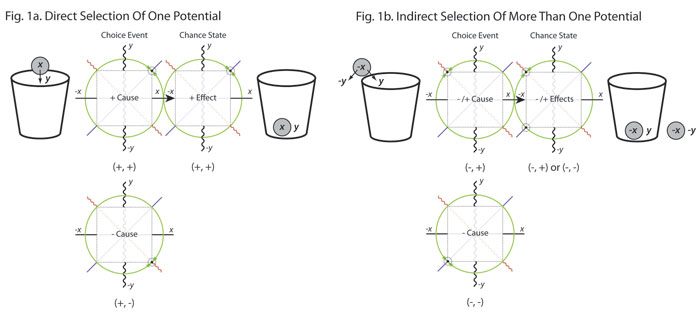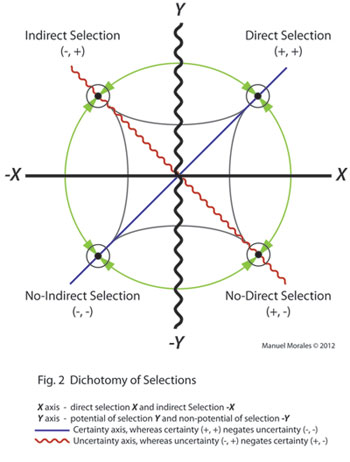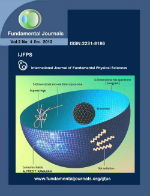Assumed Higgs Boson Discovery Proves Einstein Right
The findings of the Tempt Destiny experiment has recently been applied to the field of elementary particle physics: International Journal of Fundamental Physical Sciences (IJFPS) | |

Smithsonian/NASA Astrophysics Data System |
ABSTRACT
The selection-based Tempt Destiny experiment has provided evidence that the fundamental acts of selection are a dichotomy as are their effects. By applying this knowledge to evaluate the preliminary findings of the Higgs boson discovery, we find an omission error has taken place.
Keywords: Higgs boson, Albert Einstein, hidden variables, John S Bell, Tempt Destiny experiment.
INTRODUCTION:
In the midst of completing the initial research findings of the twelve year selection-based Tempt Destiny (TD) experiment (Morales, 2011) physicists at CERN announced on July 4, 2012, that they may have found the elusive Higgs boson (CERN, 2012), a elementary particle in the Standard Model of particle physics associated with the Higgs field which is theorized as the mechanism that gives all matter in the universe its mass (Robinson, 2011). Since the construct of the TD experiment pertains to the causal acts of direct and indirect selections, without which the proton collisions and their subsequent effects would not have occurred, an inquiry was made to compare the results of the two divergent selection-based experiments.
Several physicists involved with the Higgs boson discovery were contacted to confirm which type of collision had served as the basis of their evidence. It was revealed that their discovery focused on hard collision effects (Mukhopadhyaya, 2011) generated by the Large Hadron Collider (LHC) and not on which type of selection, e.g., a direct selection/collision of one proton into one proton or an indirect selection/collision of one proton into more than one proton, had caused the hard collisions observed. In addition, it was confirmed that all colliders including the LHC can only conduct random proton particle collisions (Longair, 2011) for it is not technically feasible to conduct directly aligned proton-to-proton particle collision experiments due to the difference between the LHC 10 micron beam size (Kuze, 2007) and the meter size of a proton (Chabay, 2011). This obstacle makes obtaining knowledge of direct collisions impossible in order to accurately distinguish the effects of both types of selection/collisions.
Without knowledge of the types of selections that caused the proton collisions to occur, the Higgs boson preliminary discovery is based on unknown causal relationships of what type of selections produced the decay products (Grupen, 2008) used as evidence to support the Higgs boson hypothesis. The omission of these initial variables may at first appear to be of no scientific significance since the primary objective of the experiments is to obtain hard collision effects which in turn would cause the desired effects of decay products, i.e., the methodology of effects causing effects. This being the case, why would the knowledge of selections be necessary or of any scientific importance?
METHOD:
Let's say that you drop a coin "directly" X into a cup as seen in Fig. 1a; the effect is certain, for there is only one potential selected Y – coin-in-cup. Conversely, you drop a coin "indirectly" -X into the cup by dropping the coin onto the rim of the cup as seen in Fig. 1b; the effect is uncertain, for there is more than one potential selected Y – coin-in-cup/coin-not-in-cup. By obtaining certain effects (+, +) from a direct selection (+, +) and by obtaining uncertain effects (-, +) or (-, -) from an indirect selection (-, +), you now have obtain, and therefore addressed, all causal possibilities.

The importance of the causal relationships of the two acts of selection is not trivia for they are necessary to cause the predetermined effects of the physical states of certainty and uncertainty. As exhibited in Figs. 1a & 1b, when no direct selection (+, -) or no indirect selection (-, -) occurs no physical effects exist. An analysis of the coin-in-cup experiment reveals that a direct selection is a noncommutative pairing of a selection X of a singular potential Y, thus the selection is determinate and therefore a positive selection (+, +). Whereas an indirect selection is a commutative pairing of multiple potentials Y with one selection -X, thus the selection is non-determinate and therefore a negative selection (-, +). A direct selection X of no potentials -Y and an indirect selection -X of no potentials -Y consists of all non-causal possibilities, thus confirming that a selection cannot exist without a potential and vice versa. This shows that potentials without the acts of selection makes potentials a certainty (-, -) and therefore no longer valid as potentials. In other words, uncertainty without certainty makes uncertainty a certainty, i.e., a paradox. The construct of having both commutative and noncommutative selection paradigms reveals a complementary and symmetrical deterministic mechanism consisting of two dichotomies, one that is precise and determinate, and one that is non-precise and non-determinate. Therefore, in order to obtain knowledge of what caused an effect such as a proton collision, it is necessary to obtain knowledge of the selection made in order to accurately discern if the collision effects are determinate or non-determinate.
As exhibited in Fig. 2, the dichotomy of selection (x, -x) and the dichotomy of potentials (y, -y) constitute both the symmetry of all possible acts of selection and the symmetry breaking of all possible acts of selection without error of omission. Together, both dichotomies form the dichotomy of selection as exhibited by the certainty axis of quadrants (+, +) (-, -) and the uncertainty axis of quadrants (-, +) (+, -). As exhibited in Figs. 1a & 1b, the dichotomies of selection correlate with the dichotomies of their effects as an absolute and precise input/output system of Choice/Chance mechanics (Morales, 2011).
You now observe the physical effects of two cups, each with a coin in them; can you tell which coin-in-cup effect (or proton collision) was generated by an indirect or direct selection? Without knowing which selection caused which effect you can only make an assumption of how the effect was caused. This knowledge is what Einstein alluded to when he stated that quantum mechanics (as used to conduct the LHC experiments) is an incomplete theory. He believed that there were hidden variables (Greenstein, 2006) that prevented us from knowing "God's thoughts" as he put it. As it turns out, he was right. The proverbial theory of everything (Ferguson, 2012) Einstein proposed many decades ago turns out to be predetermined events of selections.
One of the two teams involved in the Higgs boson preliminary discovery believes that the chance of error is only one-in-550 million (5.9 sigma) (ATLAS, 2012). However, by their own admission it is technically not feasible for them to distinguish which type of collisions they are basing their evidence on. In science, evidence based on an assumption is a speculation, not a discovery.
CONCLUSION:
The coin-in-cup experiment clearly exhibits without ambiguity or degrees of precision that effectual states are not causal in the true sense of cause and effect and any assumption that all physical effects, that which can be observed or measured, are uncertain is due to lack of knowledge of the determinate acts of selection (hidden variables) which are necessary to obtain physical effects. As the evidence shows, if the method applied to understand physical reality is via effects (proton collisions) causing effects (decay products), then we are blind to the fundamental causality of physical effects, and thus are confined to making highly calculated assumptions. It is important to note that the omission error of not taking into account the cause of the proton collisions does not imply that the extremely successful probabilistic construct of quantum mechanics is incorrect; rather, it reveals a fundamental incompleteness of any theory or methodology based on effects causing effects for it has been established that effects cannot also be the cause of themselves.
As touched upon earlier, the field of physics is the methodology of how observed or measured effects cause other effects e.g., effectual methodology. Werner Heisenberg, the creator of quantum mechanics stated, “Physics should only describe the formal relationship between observations.” (Heisenberg, 1927). So it makes perfect sense for practitioners of the art to focus on the observed effect of proton collisions which in turn caused the measured effects used as evidence for the Higgs boson preliminary discovery. As revealed in this article, the inherent problem with effectual methodology is that it is incomplete by not taking into account the initial cause of an effect such as the effect of a proton collision.
Albert Einstein was dissatisfied with the probabilistic nature of quantum mechanics prohibiting us from obtaining a full description of reality. To address this issue, in 1935 Einstein proposed the EPR (Einstein, 1935) thought experiment. However, Einstein’s notion of hidden variables was too firmly grounded in effectual methodology and was eventually contested by physicist John S. Bell’s inequality theorem (Bell, 1964). The theorem enabled a means to test the EPR argument and subsequently dispelled Einstein’s notion of local hidden variables conditioned upon the lack of evidence of absolute determinism. The evidence of an absolute and precise input/output system as exhibited by the coin-in-cup experiment confirms that a theory of absolute physical determinism (Bajić, 2005) is valid in that all events are predetermined via the causal acts of selection of potentials, without which, effectual states of certainty and uncertainty cannot exist. However, the assumption that all events are certain, or all events are uncertain, is invalid for the two causal acts of selection are a dichotomy as are their effects.
As previously stated, the TD experiment is a “selection-based” experiment which can be easily replicated by other selection-based experiments such as the coin-in-cup experiment even though the TD experiment consisted of thirty two selections of potentials conducted annually over a period of twelve months for twenty four hours a day seven days a week via the internet. The two vastly different experiments show that subject matter, location, quantity of choices to choose from, or the frequency of choices are irrelevant to the causal acts of Choice/Chance mechanics, without which, even a direct selection of one proton into one proton or an indirect selection of one proton into more than one proton cannot take place. At a physics convention (APS, 2011) on April 30, 2011, in presenting the Physics of Predetermined Events: Complementarity States of Choice Chance Mechanics manuscript, the coin-in-cup experiment was first introduced and conducted by the audience which served to demonstrate, and thus obtain repeatable evidence of predetermined events, i.e., absolute determinism.
The application of Choice/Chance mechanics as described in this article, show us that the type of selection made predetermines whether the existence of an effect is certain or uncertain. However, this pre-physical knowledge does not describe the observed or measured physical properties of the effects that follow. With the combination of the pre-physical causal acts of selection and their effectual physical properties, we are then able to obtain a more complete understanding of nature and a full description of reality.
When a new discovery has been presented that has not been considered before or that has a fundamental impact on the art, then it is the responsibility of the practitioners of the art to address it. To do otherwise would serve to willingly undermine the credibility of the art of science.
REFERENCES
- APS Meeting (2011, April 30). American Physical Society meeting, Session E13: Energy Research and Applications. Retrieved from http://meetings.aps.org/link/BAPS.2011.APR.E13.9
- ATLAS Collaboration. (2012). Observation of a new particle in the search for the Standard Model Higgs boson with the ATLAS detector at the LHC. Physics Letters B, 716(1), 1-29.
- Bajić, V. B., & Tan, T. W. (2005). Information processing and living systems (pp. 145-146). London: Imperial College Press.
- Bell, J. S. (1964). On the Einstein-Podolsky-Rosen Paradox. Physics, 1(3), 195-200.
- CERN experiments observe particle consistent with long-sought Higgs boson. (2012, July 04). CERN Press Office. Retrieved from http://press.web.cern.ch/press-releases/2012/07/cern-experiments-observe-particle-consistent-long-sought-higgs-boson
- Chabay, R. W., & Sherwood, B. A. (2011). Matter & interactions (p. 555). Hoboken, NJ: Wiley
- Einstein, A., Podolsky, B., & Rosen, N. (1935). Can Quantum-Mechanical Description of Physical Reality be Considered Complete? Physical Review, 47, 777-780. doi: 10.1103/PhysRev.47.777
- Ferguson, K. (2012). Stephen Hawking: An unfettered mind (p. 14). New York, NY: Palgrave Macmillan.
- Greenstein, G., & Zajonc, A. (2006). The quantum challenge: Modern research on the foundations of quantum mechanics (pp. 123-132). Sudbury, MA: Jones and Bartlett.
- Grupen, C., Shwartz, B. A., & Spieler, H. (2008). Particle detectors (p. 197). Cambridge, UK: Cambridge University Press
- Heisenberg, W. (1927). Über den anschaulichen Inhalt der quantentheoretischen Kinematik und Mechanik. Z. Für Phys., 43, 172-198.
- Kuze, M., Nagano, K., & Tokushuku, K. (2007). Deep inelastic scattering: Proceedings of the 14th International Workshop, Tsukuba, Japan, 20-24 April 2006 (p. 297). Singapore: World Scientific.
- Longair, M. S. (2011). High energy astrophysics (pp. 282-283). Cambridge: Cambridge University Press.
- Morales, M. (2011, April). PHYSICS OF PREDETERMINED EVENTS: Complementarity States of Choice-Chance Mechanics. NASA ADS. Retrieved from http://labs.adsabs.harvard.edu/ui/abs/2011APS..APRE13009M
- Mukhopadhyaya, B., & Raychaudhuri, A. (2011). Physics at the large hadron collider. (p. 85) (A. Datta, Ed.). [S.l.]: Springer.
- Robinson, M. B. (2011). Symmetry and the standard model: Mathematics and particle physics (p. 49). New York: Springer.
Absolute Determinism Notation
The term determinism simply implies that a system behaves the same each time it is "replayed", e.g., direct and indirect selection - same results each time. So we have only two mutually exclusive and jointly exhaustive input variables of selection (cause) which in turn predetermines the two output variables of the physical states of certainty and uncertainty (effect). If you have knowledge of which type of selection has been made, you then have knowledge of the physical state of that selection prior to its existence. If we do not know which type of selection has been made (cause), then at least we can understand why we can "only" speculate. As it currently stands, we perceive that physical states (effects in space time) cause physical states (effects in space time) and think the paradox of effectual causality is reality.
As the Tempt Destiny experiment clearly demonstrates, for a selection to be causal it cannot exist as a selection until it pairs with its potential. In other words causality cannot exist in space time as a something (effect) in order to cause a something in space time (effect).
Home I Legacy I Program I Science I Stats I Store I Contact
The quest for the next Tempt Destiny™ billboard is provided as a means for fans
to support their team and is not affiliated with the National Football League or NFL teams.
All Rights reserved. Designed and hosted by Morales Studio LLC Copyright © 2018









